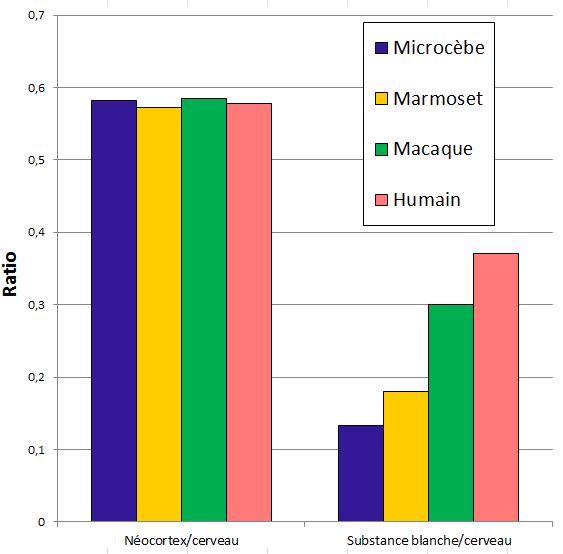The taxonomic order of primates is a branch of mammals dating to approximately 60 million years ago. The order diverged into numerous other branches, giving birth to a diversity of species including lemurs in Madagascar, monkeys in both the new world (marmosets, spider monkeys, etc.) and the old (macaques, baboons, etc.), and the great apes (orangutans, chimpanzees, gorillas and humans). The brains and cognitive abilities of primates have evolved differently among the various families, genuses and species. Understanding the cerebral mechanisms underlying cognitive evolution is one of the greatest challenges in evolutionary biology.
The neocortex, i.e., the external layer of the mammalian brain, is involved in information integration and cognitive function. Numerous articles published in the 1980s had suggested that the development of the brain and cognitive capacities of certain primates was associated with the "cerebrotype", that is, the measure of the increase in the size of the neocortex in relation to the size of the brain as a whole.
A team from MIRCen recently created a digital anatomical atlas of the brain of the world's smallest primate, the mouse lemur (Microcebus murinus). This member of the Lemuroidea superfamily has a tiny brain, weighing only two grams, and has often been considered evolutionarily simple, given its phylogenic distance from humans. The creation of an anatomical atlas of its brain enabled a comparison with those of other primates (marmosets, macaques and humans). The MIRCen researchers thus showed that the ratio between the volume of the neocortex and that of the entire brain, approximately 56%, was the same across all primates, including the mouse lemur. In other words, although the great apes and monkeys have larger brains overall than the mouse lemurs, the neocortex remains proportionally comparable between them. This discovery brings into question the long-standing belief that primate evolution is associated with a relative increase in the size of the neocortex. That dogma was built upon post-mortem animal brain studies employing technique so complex that they were only done once, in the 1980s. In contrast, the MIRCen team worked with easily reproducible and easily sharable data gathered from nuclear magnetic resonance imaging studies.
In contrast to their neocortex discovery, the MIRCen team also found that the volume of the entire brain compared to that of its white matter, which comprises the nerve fibers that enable cerebral inter-regional communication, did vary considerably across the different types of primates. That brain to white matter ratio indeed appeared to correlate with the level of brain and cognitive development of the species, being low in mouse lemurs, intermediary in macaques and maximal in humans. The MIRCen study thus demonstrated significant variability in the white matter of primates. These new data contribute greatly to a better understanding of the evolution of the primate brain and the mechanisms underlying its organization. They furthermore illustrate the importance of imaging studies in the exploration of the brain.
